Idemitsu Shokai Founded in Moji (1911)
On June 20, 1911, Idemitsu Shokai, the predecessor of Idemitsu Kosan, took its first steps in the oil sales business at the trading port of Moji in Kitakyushu, Japan.
At that time, Fukuoka Prefecture accounted for more than 70% of Japan’s coal production. However, since his time as a student company founder Sazo Idemitsu, who hailed from Munakata in Fukuoka Prefecture, had focused on the future potential of petroleum rather than coal, and in his graduation thesis he described with certainty the future prospects arising from the economic advantages of petroleum.
At the time of the company’s founding, the dominance of the two major foreign oil companies Standard Oil (now Exxon) of the United States and Rising Sun (now Shell) had broken down and bitter competition was unfolding among domestic oil producers, as conditions of uncertainty continued in the markets for petroleum products.
Idemitsu Shokai, which began as a distributor for Nippon Sekiyu, started first developing sales channels to coal mines and factories in the business of sale of lubricants (machine oil), adopting a policy of avoiding speculative trading and intermediary exploitation and instead seeking to benefit both producers and consumers through linking them directly with each other. Based in Moji, it grew its sales channels to cover the entire island of Kyushu, Osaka, Nagoya, and even mainland China.
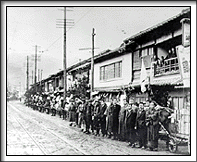
The first shipment from the head office in Moji (1917)
Overseas Branches Closed, Repatriation Begins (1945)
On August 15, 1945, with the end of the Second World War Idemitsu lost all its businesses and overseas assets. All that remained were 2.6 million yen in debts (measured in their current value at that time) and about 1,000 employees in Japan and overseas.
Beginning at the end of 1945, about 800 employees who had been dispatched to the Korean Peninsula, mainland China, and Southeast Asia returned in succession. While most firms were cutting their workforces, Idemitsu adopted and implemented a policy of not laying off any employees.
Immediately after the end of the war, as petroleum controls remained in existence Idemitsu was in charge only of details of oil distribution at a number of branches including Wakamatsu, Beppu, and Nagoya – a task that had continued since during wartime. Since there was no work for repatriated staff to do, the company decided to endure the emergency situation by taking on a variety of businesses, such as recovery of oil from the bottom of former Japan Navy tanks, radio repairs and sales, printing, agriculture, production of soy sauce and vinegar, and marine products industry.
While most of these businesses ended in failure, the radio repairs and sales business opened about 50 shops in major cities across Japan, serving as a preparation for the future development of Idemitsu’s retail network in the oil business.
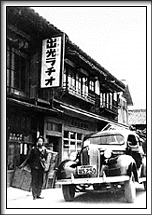
The Electrical Division’s Iizuka shop (Fukuoka)
The Nissho Maru Incident: Challenging the Dominance of the Major Oil Firms (1953)
In March 1953, Idemitsu secretly sent the second-generation Nissho Maru to Iran, which was involved in a dispute with Great Britain after nationalizing its oil industry. Loaded with about 22,000 kiloliters of gasoline and diesel oil, the Nissho Maru returned to the Port of Kawasaki in May, greeted by welcoming crowds.
In response, the British Anglo-Iranian Oil Company (the predecessor of BP) sued Idemitsu in Tokyo District Court, claiming ownership of the Nissho Maru’s cargo. This “Nissho Maru Incident” would be fought out in the courts. The judicial process was reported on in detail in the newspapers day after day, and in the end Idemitsu was victorious, as the Anglo-Iranian Oil Company dropped its case.
Imports of Iranian oil ended in 1956, after the unity of the major oil firms (international oil capital) again strengthened in Iran.
However, this incident was a predecessor of direct trades with oil-producing states and served as an impetus in turning the eyes of Japanese people to the Middle East. History also shows that the incident was seen in the Japan of that time, which had lost its confidence as a result of its loss in World War II, as a heroic deed that helped the nation regain its stature in international society.
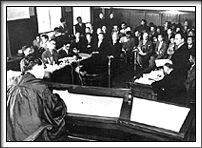
The first oral arguments in the Tokyo District Court (May 1953)
Completion of the Tokuyama Refinery (1957)
As a postwar petroleum policy, Japan adopted the method of refining oil in the market where it was consumed-that is, importing crude oil and refining it into products in Japan-with the intended course being one of gradually reducing and then eventually eliminating allocation of foreign currency to imports of oil products.
Immediately after being named a primary oil distributor, Idemitsu began preparations toward construction of a refinery. After receiving disposal of the former site of a Japan Navy fuel depot in the city of Tokuyama in Yamaguchi Prefecture, in March 1957 it completed the Tokuyama Refinery.
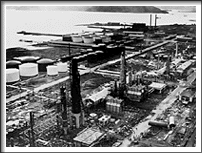
The Tokuyama Refinery under construction
Major highlights of this refinery were its state-of-the-art automated equipment and the green belt planted around the perimeter of the facility-an initiative in plant greenification and beautification at a time before concerns had arisen about pollution-related problems. The color schemes of the refinery’s equipment and structures were chosen to be in harmony with the surrounding scenery as well.
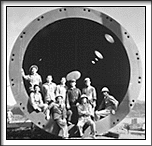
The Tokuyama Refinery under construction
Construction of Mammoth Tankers (1962)
In response to the Suez Canal Incident of 1956, shipbuilders began constructing mammoth tankers with capacities of 66,000 tons or more, which could be competitive even when traveling over routes via Capetown. Starting with the Universe Admiral (85,000-ton capacity) in 1956, Idemitsu then went on to build the third-generation Nissho Maru, at the time the world’s largest tanker with a capacity of 139,000 tons.
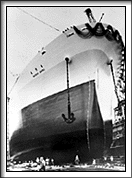
The third-generation Nissho Maru nears completion
Also, in August 1962 Idemitsu Tanker was established in the international tanker business, as Idemitsu began full-fledged participation in the maritime shipping business for the first time since the war. In December 1966, the Idemitsu Maru (209,000-ton capacity), the world’s first 200,000-ton-class very large crude carrier (VLCC) was commissioned.
Together with securing a stable supply of crude oil through using its own vessels, Idemitsu’s construction of large tankers also contributed to the development of the shipbuilding industry in Japan.
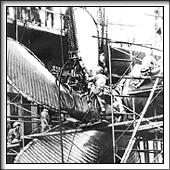
Attaching the screw propeller to the Idemitsu Maru
Chiba Refinery Completed/Idemitsu Withdraws from the PAJ (1963)
In January 1963, Idemitsu’s second refinery, the Chiba Refinery, was completed on a site in the Keiyo Industrial Zone.
However, even this refinery, which at the time boasted the largest size of any in the East Asian region, remained constrained by production adjustments implemented under the Petroleum Industry Law enacted in July of the previous year, so that it was permitted to produce only one-half its capacity (50,000 barrels/day).
The framework of this Petroleum Industry Law included demand and supply adjustments and the requirement for facility permits, intended to secure a stable and low-cost supply of petroleum as part of Japan’s comprehensive energy policies. The result was a high level of regulation, and Idemitsu strongly opposed this system as one that was harmful to the interests of consumers and threatening to the existence of the petroleum industry.
Following enactment of this law, due to production shortages resulting from government-ordered production adjustments Idemitsu was forced to purchase products from the market at relatively higher prices. In protest at these conditions, in November 1963 it withdrew from the Petroleum Association of Japan, since the production adjustments had been implemented in the form of voluntary adjustments by the PAJ.
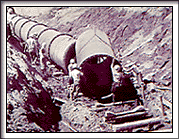
At the end of 1966 oil production adjustments were discontinued ostensibly, and in October of that year Idemitsu rejoined the PAJ. However, even after that administrative guidance by the Japanese government continued, with the result that the structure of the petroleum industry was weakened.
At the same time, in 1967 the second phase of construction took place at the Chiba Refinery, expanding its secondary atmospheric distillation unit. Today, backed by the massive consumption zone of the greater Tokyo area, it serves as Idemitsu’s central refinery.
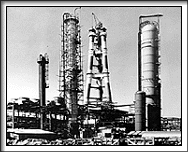
The secondary atmospheric distillation unit under construction
Construction of Mammoth Tankers (1966)
In response to the Suez Canal Incident of 1956, shipbuilders began constructing mammoth tankers with capacities of 66,000 tons or more, which could be competitive even when traveling over routes via Capetown. Starting with the Universe Admiral (85,000-ton capacity) in 1956, Idemitsu then went on to build the third-generation Nissho Maru, at the time the world’s largest tanker with a capacity of 139,000 tons.

The third-generation Nissho Maru nears completion
Also, in August 1962 Idemitsu Tanker was established in the international tanker business, as Idemitsu began full-fledged participation in the maritime shipping business for the first time since the war. In December 1966, the Idemitsu Maru (209,000-ton capacity), the world’s first 200,000-ton-class very large crude carrier (VLCC) was commissioned.
Together with securing a stable supply of crude oil through using its own vessels, Idemitsu’s construction of large tankers also contributed to the development of the shipbuilding industry in Japan.

Attaching the screw propeller to the Idemitsu Maru
Idemitsu Enters the Oil Exploration and Production (1971)
In order to secure petroleum resources, in March 1966 Idemitsu made a full-fledged entry to the oil exploration and production business by applying for exploratory drilling rights on the Japan Sea continental shelf.
In March 1972, it successfully struck oil for the first time off the coast of Niigata, and in September 1976 it began production at the Aga oil and gas field, Japan’s first full-fledged undersea oil field.
Currently, within the Idemitsu Group Idemitsu Oil & Gas is responsible for overseas exploration and development while Idemitsu Oil Development is responsible for domestic exploration and development. The Group currently produces oil and gas from fields such as the Snorre Field in the Norwegian North Sea (producing 220,000 barrels/day, with Idemitsu holding a 10% interest) and the Iwafune-Oki Oil Field. As it aims to diversify its supply sources further, Idemitsu is advancing exploration and development projects centered on the Asian and Pacific regions.
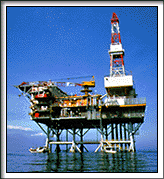
A platform in the Iwafune-Oki Oil Field
The First Oil Crisis and Advancing Overseas (1973)
The first oil crisis erupted in October 1973, spurred by the Fourth Middle East War (Yom Kippur War). Rising oil prices resulted in skyrocketing inflation or so-called vicious price spiral that directly impacted consumers and industry.
Due to government intervention in prices, the oil companies were unable to cover the rise in crude oil prices by increasing product prices, putting pressure on the pricing structure that was focused on income from gasoline alone. The effects of this would be felt in the future as well.
Also, as leadership on petroleum shifted from the major oil companies to OPEC, Idemitsu quickly decided to advance its operations into the Middle East, in light of the need to secure crude-oil supplies. In April 1973, it opened the Middle East Office in Beirut, which would serve as a base for opening a succession of offices in Tehran, Iran, Kuwait, and Riyadh, Saudi Arabia, as it strengthened its relations with oil-producing countries through direct trading in crude oil.
At the same time, Idemitsu also began full-fledged operations for purchasing and trading of crude oil and petroleum products on international petroleum markets immediately after the oil crisis, based in New York, London, and Singapore.

An Idemitsu overseas representative visits the state-run oil company in Abu Dhabi
The Establishment of Idemitsu Credit and Development of the Credit-Card Business (1986)
In 1985, Idemitsu became the first company in Japan’s oil industry to issue a credit card, the Idemitsu Card, in partnership with a bank-related credit-card issuer. The next year, in 1986, it established Idemitsu Credit Co., Ltd., to administer and manage the credit-card business.
In 1995, the Idemitsu Card introduced a cash-back system providing discounts on gasoline and other purchases at Idemitsu service stations corresponding to the amount of card use. Thanks to constantly taking the initiative, Idemitsu Credit boasts the largest number of cards issued in the industry.

Idemitsu Card
In the area of service-station membership cards for customers paying by cash, in 1993 Idemitsu again was first in the industry as it began issuing the Idemitsu Mydo Card featuring an IC chip. In 1998 it began using the abundant memory capacity of the IC card to provide new services adding prepaid (Mydo prepaid card system) and cash-back features to the cards.

Idemitsu Mydo Card
Introduction of Low-Benzene Gasoline (1993)
In June 1992, the Earth Summit was held in Rio de Janeiro, adopting a policy of sustainable development. In response, each member of Japan’s oil industry developed its own action plan for environmental protection.
As the movement toward environmental protection gained steam, in December 1993 Idemitsu began sale of Idemitsu Super Zearth (high-octane) and Idemitsu Zearth (regular) gasoline, with benzene content reduced to no more than one percent.
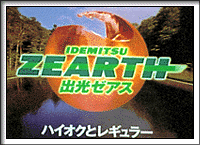
The Zearth brand name combines the words “zenith” and “earth.
At the time, benzene in the atmosphere had been identified as cancerous by a variety of organizations but the substance was not yet regulated in Japan. Beginning in April 1996, benzene content was restricted to no more than 5%-a level ratified in light of the quality level of gasoline on sale at the time. At that point, Idemitsu’s products earned Eco Mark certification as earth-friendly gasoline.

